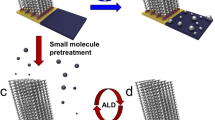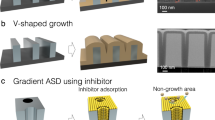Abstract
Context
Area-selective atomic layer deposition (AS-ALD) is a thin film deposition technique developed using conventional ALD by considering the surface chemical nature of the substrate. Selecting appropriate precursors is a critical step in developing an efficient AS-ALD process with high deposition selectivity. However, the current efficiency of research on viable AS-ALD precursors is limited because of the absence of theoretical design rules for precursor chemical structures. In this study, our objective is to propose molecular design principle for precursors for AS-ALD, particularly focusing on achieving high deposition selectivity of oxides on diverse substrates. Current preliminary results suggest that ML-based prediction model may provide a fundamental molecular-level understanding of the reactivity of metal oxide precursors, that can be useful for efficient selection of suitable precursors for AS-ALD.
Methods
We employ density functional theory (DFT) calculations and machine learning (ML) techniques to analyze the relationship between the structure and the surface reactivity of the precursor. Considering DFT calculation data (M06L/def2-tzvp, Gaussian 09 and Orca 4.0) and information on precursor structures, artificial neural networks (ANN, neuralnet, R) are applied to identify critical descriptors of the AS-ALD process. Furthermore, we utilize this ANN model to predict precursor reactivity according to surface terminations.







Similar content being viewed by others
Data availability
The datasets used and/or analyzed during the current study are available from the corresponding author on reasonable request.
References
George SM (2010) Atomic layer deposition: an overview. Chem Rev 110(1):111–131. https://doi.org/10.1021/cr900056b
Johnson RW, Hultqvist A, Bent SF (2014) A brief review of atomic layer deposition: from fundamentals to applications. Mater Today 17(5):236–246. https://doi.org/10.1016/j.mattod.2014.04.026
Mackus AJM, Merkx MJM, Kessels WMM (2019) From the bottom-up: toward area-selective atomic layer deposition with high selectivity. Chem Mater 31(1):2–12. https://doi.org/10.1021/acs.chemmater.8b03454
Parsons GN, Clark RD (2020) Area-selective deposition: fundamentals, applications, and future outlook. Chem Mater 32(12):4920–4953. https://doi.org/10.1021/acs.chemmater.0c00722
Cao K, Cai J, Chen R (2020) Inherently selective atomic layer deposition and applications. Chem Mater 32(6):2195–2207. https://doi.org/10.1021/acs.chemmater.9b04647
Yarbrough J, Shearer AB, Bent SF (2021) Next generation nanopatterning using small molecule inhibitors for area-selective atomic layer deposition. J Vac Sci Technol, A 39(2):021002. https://doi.org/10.1116/6.0000840
Crutchley RJ (2013) CVD and ALD precursor design and application. Coord Chem Rev 257(23):3153. https://doi.org/10.1016/j.ccr.2013.08.006
Fang G, Xu L, Cao Y, Li A (2016) Theoretical design and computational screening of precursors for atomic layer deposition. Coord Chem Rev 322:94–103. https://doi.org/10.1016/j.ccr.2016.05.011
Huang L, Han B, Han B, Derecskei-Kovacs A, Xiao M, Lei X, O’Neill ML, Pearlstein RM, Chandra H, Cheng H (2014) Density functional theory study on the full ALD process of silicon nitride thin film deposition via BDEAS or BTBAS and NH3. Phys Chem Chem Phys 16(34):18501–18512. https://doi.org/10.1039/C4CP02741H
Park B-E, Oh I-K, Lee CW, Lee G, Shin Y-H, Lansalot-Matras C, Noh W, Kim H, Lee H-B-R (2016) Effects of Cl-based ligand structures on atomic layer deposited HfO2. J Phys Chem C 120(11):5958–5967. https://doi.org/10.1021/acs.jpcc.5b05286
Shahmohammadi M, Mukherjee R, Takoudis CG, Diwekar UM (2021) Optimal design of novel precursor materials for the atomic layer deposition using computer-aided molecular design. Chem Eng Sci 234:116416. https://doi.org/10.1016/j.ces.2020.116416
Yu N-K, Moon CH, Park J, Lee H-B-R, Shong B (2021) Evaluation of silicon tetrahalide precursors for low-temperature thermal atomic layer deposition of silicon nitride. Appl Surf Sci 565:150603. https://doi.org/10.1016/j.apsusc.2021.150603
Kim M, Shin E, Song H, Nam Y, Kim D-H, Hwang J-H, Shong B (2023) Rational molecular design for non-aqueous atomic layer deposition of zinc oxide. Chem Mater 35(12):4669–4679. https://doi.org/10.1021/acs.chemmater.3c00143
Xu Y, Musgrave CB (2004) A DFT study of the Al2O3 atomic layer deposition on SAMs: effect of SAM termination. Chem Mater 16(4):646–653. https://doi.org/10.1021/cm035009p
Murray CA, Elliott SD, Hausmann D, Henri J, LaVoie A (2014) Effect of reaction mechanism on precursor exposure time in atomic layer deposition of silicon oxide and silicon nitride. ACS Appl Mater Interfaces 6(13):10534–10541. https://doi.org/10.1021/am5021167
Seo S, Yeo BC, Han SS, Yoon CM, Yang JY, Yoon J, Yoo C, Kim H, Lee Y, Lee SJ, Myoung J-M, Lee H-B-R, Kim W-H, Oh I-K, Kim H (2017) Reaction mechanism of area-selective atomic layer deposition for Al2O3 nanopatterns. ACS Appl Mater Interfaces 9(47):41607–41617. https://doi.org/10.1021/acsami.7b13365
Kim HG, Kim M, Gu B, Khan MR, Ko BG, Yasmeen S, Kim CS, Kwon S-H, Kim J, Kwon J, Jin K, Cho B, Chun J-S, Shong B, Lee H-B-R (2020) Effects of Al precursors on deposition selectivity of atomic layer deposition of Al2O3 using ethanethiol inhibitor. Chem Mater 32(20):8921–8929. https://doi.org/10.1021/acs.chemmater.0c02798
Suh T, Yang Y, Zhao P, Lao KU, Ko H-Y, Wong J, DiStasio RA Jr, Engstrom JR (2020) Competitive adsorption as a route to area-selective deposition. ACS Appl. Mater. Interfaces 12(8):9989–9999. https://doi.org/10.1021/acsami.9b22065
Lee J, Lee J-M, Oh H, Kim C, Kim J, Kim DH, Shong B, Park TJ, Kim W-H (2021) Inherently area-selective atomic layer deposition of SiO2 thin films to confer oxide versus nitride selectivity. Adv Func Mater 31(33):2102556. https://doi.org/10.1002/adfm.202102556
Lan Y, Wen Y, Li Y, Yang J, Cao K, Shan B, Chen R (2022) Selectivity dependence of atomic layer deposited manganese oxide on the precursor ligands on platinum facets. J Vac Sci Technol, A 41(1):012402. https://doi.org/10.1116/6.0002173
Li J, Tezsevin I, Merkx MJM, Maas JFW, Kessels WMM, Sandoval TE, Mackus AJM (2022) Packing of inhibitor molecules during area-selective atomic layer deposition studied using random sequential adsorption simulations. J Vac Sci Technol, A 40(6):062409. https://doi.org/10.1116/6.0002096
Nguyen CT, Cho E-H, Gu B, Lee S, Kim H-S, Park J, Yu N-K, Shin S, Shong B, Lee JY, Lee H-B-R (2022) Gradient area-selective deposition for seamless gap-filling in 3D nanostructures through surface chemical reactivity control. Nat Commun 13(1):7597. https://doi.org/10.1038/s41467-022-35428-6
Yarbrough J, Pieck F, Grigjanis D, Oh I-K, Maue P, Tonner-Zech R, Bent SF (2022) Tuning molecular inhibitors and aluminum precursors for the area-selective atomic layer deposition of Al2O3. Chem Mater 34(10):4646–4659. https://doi.org/10.1021/acs.chemmater.2c00513
Yun S, Wang H, Tom M, Ou F, Orkoulas G, Christofides PD (2023) Multiscale CFD modeling of area-selective atomic layer deposition: application to reactor design and operating condition calculation. Coatings 13(3):558. https://doi.org/10.3390/coatings13030558
Butler KT, Davies DW, Cartwright H, Isayev O, Walsh A (2018) Machine Learning for molecular and materials science. Nature 559(7715):547–555. https://doi.org/10.1038/s41586-018-0337-2
Artrith N, Butler KT, Coudert F-X, Han S, Isayev O, Jain A, Walsh A (2021) Best practices in machine learning for chemistry. Nat Chem 13(6):505–508. https://doi.org/10.1038/s41557-021-00716-z
Schleder GR, Padilha ACM, Acosta CM, Costa M, Fazzio A (2019) From DFT to machine learning: recent approaches to materials science–a review. J Phys Mater 2(3):032001. https://doi.org/10.1088/2515-7639/ab084b
Ong SP (2019) Accelerating materials science with high-throughput computations and machine learning. Comput Mater Sci 161:143–150. https://doi.org/10.1016/j.commatsci.2019.01.013
Jinnouchi R, Asahi R (2017) Predicting catalytic activity of nanoparticles by a DFT-aided machine-learning algorithm. J Phys Chem Lett 8(17):4279–4283. https://doi.org/10.1021/acs.jpclett.7b02010
Li G, Hu Z, Hou F, Li X, Wang L, Zhang X (2020) Machine learning enabled high-throughput screening of hydrocarbon molecules for the design of next generation fuels. Fuel 265:116968. https://doi.org/10.1016/j.fuel.2019.116968
Mehmood T, Liland KH, Snipen L, Sæbø S (2012) A review of variable selection methods in partial least squares regression. Chemom Intell Lab Syst 118:62–69. https://doi.org/10.1016/j.chemolab.2012.07.010
Neese F (2018) Software update: the ORCA program system, version 4.0. WIREs Comput Mol Sci 8(1):e1327. https://doi.org/10.1002/wcms.1327
Frisch MJ, Trucks GW, Schlegel HB, Scuseria GE, Robb MA, Cheeseman JR, Scalmani G, Barone V, Petersson GA, Nakatsuji H et al (2016) Gaussian 16
Zhao Y, Truhlar DG (2006) A new local density functional for main-group thermochemistry, transition metal bonding, thermochemical kinetics, and noncovalent interactions. J Chem Phys 125(19):194101. https://doi.org/10.1063/1.2370993
Weigend F, Ahlrichs R (2005) Balanced basis sets of split valence, triple zeta valence and quadruple zeta valence quality for H to Rn: design and assessment of accuracy. Phys Chem Chem Phys 7(18):3297–3305. https://doi.org/10.1039/B508541A
Raghavachari K, Halls MD (2004) Quantum chemical studies of semiconductor surface chemistry using cluster models. Mol Phys 102(4):381–393. https://doi.org/10.1080/00268970410001675590
Duan Y, Lin J-M, Teplyakov AV (2015) Computational investigation of electronic and steric effects in surface reactions of metalorganic precursors on functionalized silicon surfaces. J Phys Chem C 119(24):13670–13681. https://doi.org/10.1021/acs.jpcc.5b02722
Huang L, Han B, Fan M, Cheng H (2017) Design of efficient mono-aminosilane precursors for atomic layer deposition of SiO2 thin films. RSC Adv 7(37):22672–22678. https://doi.org/10.1039/C7RA02301D
Adamczyk AJ, Cooper AC, Kim M-S, Ivanov SV (2018) Leveraging atomistic modeling during precursor design for cobalt film deposition. Comput Aided Chem Eng 44:157–162. https://doi.org/10.1016/B978-0-444-64241-7.50021-5
Kaur P, Mai L, Muriqi A, Zanders D, Ghiyasi R, Safdar M, Boysen N, Winter M, Nolan M, Karppinen M, Devi A (2021) Rational development of guanidinate and amidinate based cerium and ytterbium complexes as atomic layer deposition precursors: synthesis, modeling, and application. Chem - A Eur J 27(15):4913–4926. https://doi.org/10.1002/chem.202003907
Kaneda Y, Nye RA, Marques EA, Armini S, Delabie A, van Setten MJ, Pourtois G (2023) A first-principles investigation of the driving forces defining the selectivity of TiO2 atomic layer deposition. J Phys Chem C 127(21):10303–10314. https://doi.org/10.1021/acs.jpcc.3c00965
Fritsch S, Guenther F, Guenther MF (2019) Package ‘Neuralnet.’ Train Neural Netw 2:30
Database of ALD Processes (2023) https://doi.org/10.6100/ALDDatabase
Funding
This research was funded by the Ministry of Trade, Industry and Energy (Grant Number: RS-2022–00143881). This work was supported by the National Research Foundation of Korea (NRF) grant funded by the Korea government (MSIT, RS-2023–00210186).
Author information
Authors and Affiliations
Contributions
Conceptualization: JK, BS. Data curation: TTNV, CK. Formal Analysis: TTNV, CK. Funding acquisition: JK, BS. Investigation: TTNV, CK. Methodology: TTNV, CK. Project administration: JK, BS. Resources: HL, JK, BS. Software: TTNV, CK. Supervision: JK, BS. Validation: TTNV, CK, HL. Visualization: TTNV, CK. Writing – original draft: TTNV, CK. Writing – review & editing: HL, JK, BS.
Corresponding authors
Ethics declarations
Ethics approval and consent to participate
Not applicable.
Consent for publication
Not applicable.
Competing interests
The authors declare no competing interests.
Additional information
Publisher's Note
Springer Nature remains neutral with regard to jurisdictional claims in published maps and institutional affiliations.
Supplementary Information
Below is the link to the electronic supplementary material.
Rights and permissions
Springer Nature or its licensor (e.g. a society or other partner) holds exclusive rights to this article under a publishing agreement with the author(s) or other rightsholder(s); author self-archiving of the accepted manuscript version of this article is solely governed by the terms of such publishing agreement and applicable law.
About this article
Cite this article
Ngoc Van, T.T., Kim, C., Lee, H. et al. Machine learning-based exploration of molecular design descriptors for area-selective atomic layer deposition (AS-ALD) precursors. J Mol Model 30, 10 (2024). https://doi.org/10.1007/s00894-023-05806-y
Received:
Accepted:
Published:
DOI: https://doi.org/10.1007/s00894-023-05806-y




